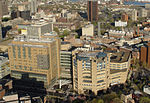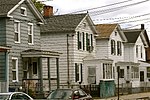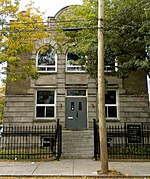Union Station, also known as New Haven Railroad Station (IATA: ZVE) or simply New Haven, is the main railroad passenger station in New Haven, Connecticut. It is the third such station in the city of New Haven, preceded by both an 1848 built station in a different location, and an 1879 built station near the current station's location. Designed by noted American architect Cass Gilbert, the present beaux-arts Union Station was completed and opened in 1920 after the previous Union Station (which was located at the foot of Meadow Street, near the site of the current Union Station parking garage) was destroyed by fire. It served the New York, New Haven and Hartford Railroad for the next five decades, but fell into decline following World War II along with the United States railroad industry as a whole.
The New Haven Railroad went bankrupt in 1961, and the station was transferred to the Penn Central Transportation Company along with the rest of the New Haven Railroad on January 1, 1969. Penn Central itself went bankrupt the next year, and the station building was closed in 1973 to cut costs, leaving only the under-track 'subway' open for passengers. The station was listed on the National Register of Historic Places on September 3, 1975, but it was almost demolished before being saved by the Northeast Corridor Improvement Project in 1979, which began work to rehabilitate the station building. Reopened after extensive renovations in early 1985, it is now the most important transportation hub in New Haven. In the 21st century, it is the busiest train station in the state of Connecticut by passengers served, as well as one of the most used stations of Amtrak's entire network.The property is listed on the National Register of Historic Places as New Haven Railroad Station. Its significance is partly as an example of the work of Cass Gilbert, who also designed the Woolworth Building in New York and the U.S. Supreme Court Building. The restored building features interior limestone walls, ornate ceilings, chandeliers and striking stainless steel ceilings in the tunnels to the trains. The large waiting room is thirty-five feet high and features models of NYNH&HRR trains on the benches.
Located at the intersection of the Northeast Corridor and the New Haven–Springfield Line, the station serves a variety of train services, including Amtrak, CT Rail, Metro-North, and Shore Line East.








